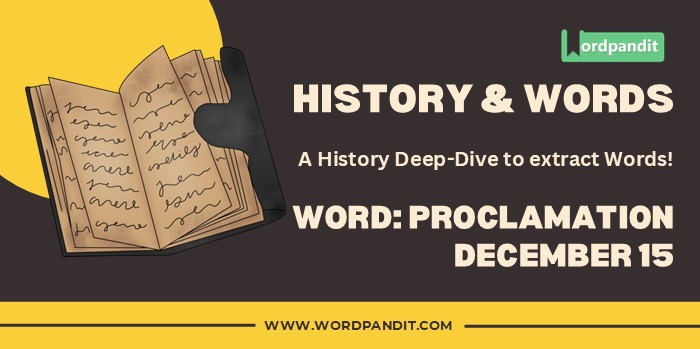History & Words: ‘Proclamation’ (December 15)
Welcome to ‘History & Words.’ 🌟 I’m Prashant, founder of Wordpandit and the Learning Inc. Network. This series combines my passion for language learning with historical context. Each entry explores a word’s significance on a specific date, enhancing vocabulary while deepening understanding of history. Join me in this journey of words through time.
📚 Table of Contents
🔍 Word of the Day: Proclamation
Pronunciation: /ˌprɒkləˈmeɪʃən/ (prok-luh-MAY-shun)
🌍 Introduction
On December 15, 1791, Virginia became the tenth state to ratify the Bill of Rights, reaching the threshold needed to amend the Constitution and formally proclaim these fundamental civil liberties as the law of the land. This historic proclamation established explicit protections for individual rights and liberties in the United States, creating a model that would influence democratic movements worldwide.
The word “proclamation” carries special weight in political and legal contexts, representing formal declarations that change the course of history. From royal decrees to constitutional amendments, proclamations have served as vehicles for announcing and establishing significant changes in law and society.
🌱 Etymology
The term “proclamation” comes from the Latin “proclamatio,” derived from “proclamare,” meaning “to cry out” or “to publicly declare.” This combines “pro-” (forth) and “clamare” (to cry out), reflecting its origin as a public announcement made by calling out to assembled people.
📖 Key Vocabulary
- 🔑 Ratification: The formal approval or confirmation of a previous commitment
- 🔑 Amendment: A formal alteration to a legal document
- 🔑 Civil Liberties: Rights and freedoms protected from government interference
- 🔑 Constitution: The fundamental principles by which a nation is governed
- 🔑 Federation: A union of partially self-governing states under a central government
🏛️ Historical Context
The Bill of Rights emerged from intense debates during the ratification of the U.S. Constitution. Anti-Federalists demanded explicit protections for individual rights as a condition for supporting the new government.
James Madison, initially skeptical of the need for such amendments, became their primary architect and champion, crafting language that would protect individual liberties while preserving federal authority.
The process of ratification involved complex negotiations among the states, each weighing the balance between federal power and individual rights.
⏳ Timeline
- 1787: Constitutional Convention concludes
- 1788: Constitution ratified
- June 8, 1789: Madison proposes Bill of Rights
- September 25, 1789: Congress approves Bill of Rights
- December 15, 1791: Virginia ratifies, completing adoption
- 1992: 27th Amendment ratified (originally part of Madison’s proposals)
- 1941: December 15 designated as Bill of Rights Day
- 2016: 225th anniversary celebration
🌟 The Day’s Significance
December 15, 1791, represents the culmination of a lengthy process to establish explicit constitutional protections for individual rights. Virginia’s ratification made the Bill of Rights official, fundamentally shaping American jurisprudence.
The first ten amendments proclaimed essential freedoms: speech, religion, press, assembly, and petition in the First Amendment; the right to bear arms in the Second; protections against unreasonable search and seizure in the Fourth; and crucial legal protections in the Fifth through Eighth Amendments.
This proclamation of rights set a precedent for constitutional democracy, inspiring similar declarations worldwide and establishing principles that continue to guide legal interpretation today.
💬 Quote
“If men were angels, no government would be necessary. If angels were to govern men, neither external nor internal controls on government would be necessary.” – James Madison, Federalist No. 51
🔮 Modern Usage and Reflection
Today, “proclamation” retains its formal significance in government and law, while the Bill of Rights continues to evolve through judicial interpretation and application to modern contexts, particularly regarding technology and privacy rights.
🏛️ Legacy
The Bill of Rights has influenced constitutional development worldwide and continues to shape debates about civil liberties, government power, and individual rights. Its principles have been tested and reaffirmed through numerous Supreme Court decisions and social movements.
🔍 Comparative Analysis
While earlier documents like England’s Magna Carta and various colonial charters protected certain rights, the Bill of Rights represented an unprecedented systematic proclamation of individual liberties within a constitutional framework.
💡 Did You Know?
🎓 Conclusion
The proclamation of the Bill of Rights on December 15, 1791, stands as a pivotal moment in the development of constitutional democracy. Its enduring influence on law, government, and civil rights demonstrates the lasting power of formally proclaimed principles to shape society.
📚 Further Reading
- 📘 “The Bill of Rights: Creation and Reconstruction” by Akhil Reed Amar
- 📗 “Original Meanings: Politics and Ideas in the Making of the Constitution” by Jack N. Rakove
- 📙 “James Madison and the Making of America” by Kevin R.C. Gutzman












